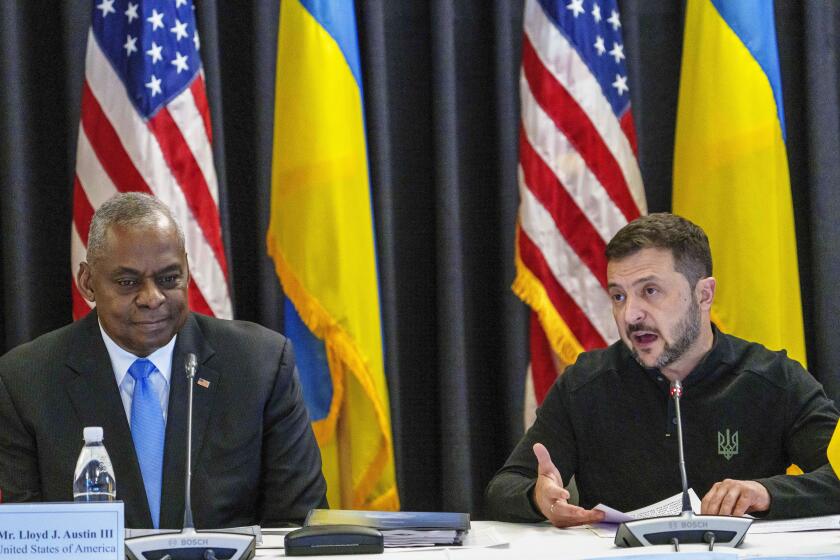‘A Decision Between Terrible and Horrible’
The storms over Wichita, Kan., were fierce and deadly the first week of June. Lightning killed a high school basketball player as he hugged a friend in a parking lot. And Mary and Jeffrey, a couple from a little town in Southern California, sat in their hotel room, gazed out their windows at the tornadoes and black skies, and felt they were looking into their souls.
They had come to Wichita from California because they had learned when Mary, 41, was nearly 27 weeks pregnant with the child they had craved that the baby was seriously, possibly fatally, ill. Down syndrome. And a heart defect so severe the perinatologist actually punched a hole through the drawing he’d made of the baby’s heart because the couple didn’t seem to be understanding him. They made what they say tearfully was the single most anguished decision of their lives. They decided, together, to terminate the pregnancy.
“For the rest of my life,” says Jeffrey, 41, “I am going to wonder if we made the right decision. We thought we did the most merciful thing. If you can acknowledge that death can be merciful, then you open the door to incredible complexity. So we opened that door a crack, and it all came rushing in.”
How, you might wonder, is it possible in this day of sophisticated medical testing that a 41-year-old woman would wait until the end of her second trimester to undergo amniocentesis? Mary had no reason to suspect her baby would be damaged. She was carrying a child that was the product of a union between her husband’s sperm and the egg of a 26-year-old donor. The decision to have amnio is always a balancing of risks--a small possibility of miscarriage from the procedure versus an ascending chance of Down as the mother ages. At the time, it didn’t seem worth the risk. In retrospect, a disastrous decision.
During routine ultrasound at 23 weeks, Mary’s obstetrician was puzzled by a shadow on the baby’s heart. He sent her to a perinatologist, who brought in a pediatric cardiologist who spent two hours looking at the baby with ultrasound.
Mary, a nurse, was grasping for hope.
“Have you ever seen those radical mothering magazines?” she asked.
“I try to keep an open mind.”
“They’re always saying these anomalies found by ultrasound don’t really exist,” she said.
The doctor looked at her.
“That’s really too bad,” he said. “It’s too bad they say that.”
*
There are, at this point in the war of attrition against doctors who perform abortions in this country, only three clinics in America where a woman in her third trimester with a severely damaged fetus can end a pregnancy. One is in Los Angeles. But Mary, with risks that include chronic asthma and a weight problem, was well outside the comfort zone of the doctor here. He referred her to Dr. George Tiller in Wichita and Dr. Warren Hern in Boulder, Colo. Tiller was able to see her first.
Tiller’s clinic, Women’s Health Care Services, is a major target of the antiabortion terrorism movement. In 1993, as he left work, Tiller, then 52, was shot in both arms by Rachelle Shannon, a fanatical Christian, who, as it turned out, had also firebombed six other abortion clinics. After Tiller was treated for his wounds, he returned to work.
In a video he made for families considering terminating late pregnancies with damaged fetuses, he seems Clark Kent-ish, a full head of dark hair, preppy glasses, and the slightly wooden delivery of a military man, not surprising since he was once a Navy flight surgeon.
Tiller offers intensive counseling and bereavement services at the clinic. He has publicly opposed third-trimester abortions, except where the mother’s health is endangered or where there is severe fetal abnormality. He does not use the late-term abortion method--intact dilation and extraction--that Congress recently attempted to outlaw.
“We believe women have more worth beyond their bio-reproductive function,” he says on the tape. “Here, the woman is the patient; the fetus is the problem.”
When she first called, Mary says, Tiller seemed to be challenging her: “You’re pretty late,” he said. “You’re pretty far along.”
He also told her he had federal marshals inside the clinic.
“Are there protesters?” Mary asked.
“If you can’t get past the protesters,” she remembers him saying, “you don’t deserve to be here.”
“Tiller unleavened is a little hard to take,” Jeffrey says. “But his staff is really great. Everyone there is a warrior. The cleaning lady carries a Glock.”
*
On the afternoon of Monday, June 3, as Mary lay on a table with Jeffrey at her side, Dr. Tiller, guided by ultrasound, inserted a needle through Mary’s abdomen, then into the baby’s heart. He injected a fatal dose of a drug called Digoxin, then left the room.
Mary and Jeffrey held each other for 20 minutes and wept.
“We blessed the baby and invited him back another time. We told each other we loved each other and then we let him go.”
After that, it was a question of waiting for an induced labor to begin, the conclusion foregone: At some point later in the week, Mary would deliver a stillborn.
“I really can’t flinch from what we did,” Jeffrey says. “That person was there, and that person was euthanized.”
Labor began the afternoon of Thursday, June 6, painful and hard.
They arrived at the clinic in a driving rain at 7:30 p.m.; with Mary under “twilight” sedation, the baby came at 10 p.m.
“When I woke up, I felt a tremendous emptiness and desire to see and hold my baby,” she says. “He was a beautiful baby, deformed and a little soggy. He was tiny and his eyes were strange. . . . As soon as that baby came, the storms were over.”
They left Kansas with photos, the baby’s ashes and footprints. Every day, Mary says, she wakes with “an emptiness and a pain that is intolerable.”
Although they choose to use pseudonyms, they speak about the experience because they resent the intrusion of politics into such a deeply personal sphere and think that if people understood the complexity of their decision, they might not be so quick to judge.
“I’m really seeing how wise the founding fathers were about the separation of church and state,” Jeffrey says. “People’s religion equips them with this dangerous kind of certainty. And certainty is a brutal thing.”
“This was,” says Mary, “a decision between terrible and horrible.”
In the end, because this is the law, the decision was theirs--theirs to ponder, theirs to make, theirs to live with. As it should be.
* Robin Abcarian’s column appears on Sundays and Wednesdays. Readers may write to her at the Los Angeles Times, Life & Style, Times Mirror Square, Los Angeles, CA 90053.
More to Read
Sign up for Essential California
The most important California stories and recommendations in your inbox every morning.
You may occasionally receive promotional content from the Los Angeles Times.










